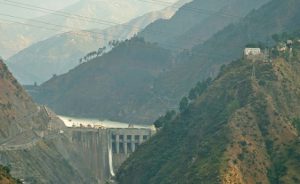Some of the fiercest environmental battles in China in recent years have been over hydropower. In this adapted excerpt from the new book China and the Environment: The Green Revolution, chinadialogue’s Liu Jianqiang tells the story of how locals worked to save Tiger Leaping Gorge – and won
Over the past eight years, the strong momentum driving the development of China’s hydropower sector has been kept in check by fierce public opposition. Chinese NGOs, the media and people displaced by dams have also played a major role.
Although the hydropower companies have long wanted to dam Tiger Leaping Gorge, work here has never started. That gorge has become like a nail stuck in the companies’ throat. The campaign to protect Tiger Leaping Gorge, which ran from 2004 to 2006, not only safeguarded one of China’s most magnificent landscapes, but it also saved the homes of more than 100,000 ethnic minority peoples, making the campaign one of the biggest success stories of the past decade for China’s green defenders.
I covered this story as a reporter for Southern Weekend. On 27 July 2004, the state news agency Xinhua reported that the NDRC had reviewed and passed the Planning Report on the Damming of the Middle Reaches of the Jinsha River. It had recommended that work should start soon on the Tiger Leaping Gorge dam. The Xinhua report added: ‘The elevation drop of Tiger Leaping Gorge is 196 metres, the ideal distance for a hydropower plant.’
In the plan, hydropower stations, forming an eight-dam cascade starting at Tiger Leaping Gorge, would be built on the middle reaches of the Jinsha River, on the first bend of the Yangtze.
Tiger Leaping Gorge would be flooded 200 kilometres upstream, in Dechen Tibetan Autonomous Prefecture, near Benzilan. It would forcibly displace 100,000 people and about 13,333 hectares of good agricultural land would be submerged.
The main public opponent of the dams at Tiger Leaping Gorge was a man named Xiao Liangzhong. He was an anthropologist and an editor at a Beijing-based publishing house, who hailed from the Tiger Leaping Gorge area. His grandmother, parents and brothers all still lived there. If the Tiger Leaping Gorge dam was built, his family home would be submerged. On 8 September 2004, I met with Xiao in the Sanlian Bookshop in Beijing’s Wangfujing shopping street. He was 31 years old and full of energy. He started to arrange a number of interviews in the Jinsha River Valley for me and my newspaper colleague Cheng Gong.
The plan to turn the middle reaches of the Jinsha River into an eight-dam cascade had Tiger Leaping Gorge at the top, and the Jinanqiao hydropower station as the fifth dam. Jinanqiao was owned by the Beijing Huarui Investment Group, and preparatory work on the dam had started in 2002. The dam was to be 156 metres high, with a total installed capacity of 2,500 megawatts. According to the plan, the river would be dammed by 2005.
Local villagers said they suspected that construction work on the Jinanqiao dam was illegal: that it had begun without approval from the central government. My colleague Cheng visited the construction site. The hydropower company had set up two security-guard posts at the entrance, blocking off any access. But with the help of local villagers, he walked along a horse caravan path used by the Lisu ethnic group to cross a mountain, and bypassed the guards. When he got round to the site, he saw various cargo trucks busying back and forth like ants, two of the dam’s diversion tunnels starting to take shape, and the main building works, such as the cofferdam, already under construction. After he was found by guards on the site, Cheng was detained for four hours.
Cheng also found out from a government source that the town of Lijiang would earn about 4 million yuan in tax revenues from the dam – and that this was why the local government there had warmly welcomed the project, making it a priority and giving it the green light at every stage.
Back in Beijing, I also made a breakthrough: an official from the NDRC told me that this project had definitely not yet been approved, and that he was very surprised to hear that it had already been started. I telephoned an official from the State Environmental Protection Administration (SEPA, now the MEP) and he also sounded shocked: ‘That’s a world-famous site of natural beauty. How could anyone build a power station there?!’ We had our evidence. This project had broken ground illegally.
Our article was published on the front page of Southern Weekend on 29 September 2004, with the headline ‘Emergency at Tiger Leaping Gorge’. It shocked the nation and focused public attention on the issue. Following our report, Chinese and international media began to cover the story. It became the biggest environmental story since the campaign to stop the Nu River dam.
The article quoted environmentalists who said that the Tiger Leaping Gorge dam could wipe out whole species. The resettlement of the Naxi ethnic group, who live along the banks of the Jinsha River, would mean the irreversible loss of the traditional sites and accumulated wisdom of their Dongba ritual culture. But supporters of the dam stressed its economic benefits. Director of the Management Bureau of the Three Parallel Rivers, Ma Suhong, said: ‘We need to lift the people out of poverty.’
His view was challenged by Xiao Liangzhong. Land in the Jinsha River Valley above Tiger Leaping Gorge was both fertile and flat, he said. It was a traditional farming community with excellent quality soil. The compensation fund for relocation was far less than what the local people would really lose. High-quality farmland would be submerged. Clearly, the skilled farmers of this river valley would be impoverished if they were evicted from their land.
The plan for the Tiger Leaping Gorge dam estimated that 100,000 people would need to be relocated. When these people were moved, they wouldn’t be able to find land as good as that they had been farming. Once-prosperous villages would sink into poverty.
Moreover, our report confirmed two important points. First, construction work on the Jinanqiao hydropower station was unlawful. Second, the 100,000 local people hadn’t been informed about what would happen to them, and were categorically opposed to being resettled.
Li Xiaoxi was an associate professor at the Air Force Command Institute, and knew an official in the office of the premier, Wen Jiabao. She called that official the day after our article was published and said that Wen should read it – and see that a dam was being built illegally at Tiger Leaping Gorge. The official replied: ‘We’ve seen this article. It’s a good story with solid facts.’ Shortly afterwards, Wen Jiabao ordered the project suspended, while the NDRC investigated the situation.
But this wasn’t the end of the story.



